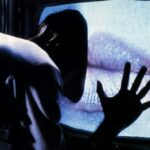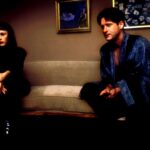Deconstructing Scary, by David Bax
This review will contain no spoilers for The Cabin in the Woods. Personally, I am not someone who believes that spoilers can truly ruin a good film but I will, as always, avoid them because there are many, especially within the internet readership upon which I rely, who disagree with me. Furthermore, I don’t see any good reasons to spoil a film in a review, which should require nothing more than a cursory plot synopsis anyway. It seems to me that those who have given away major story elements in negative write-ups of this and other films like it have done so chiefly out of arrogant bullying and an elitist attitude toward fans of genre cinema. When it comes to The Cabin in the Woods, though, there is another reason I’ll avoid spoilers. The film is lots of fun to experience as it unfolds further and further levels of bizarre gruesomeness but, absent the surprises it offers in leading you down its rabbit hole, there’s not much of substance here.
To the extent that I will describe the plot, I’ll do so thusly: five college students embark on a weekend trip to the titular structure in the titular geographical setting. There is the alpha couple, Jules (Anna Hutchinson, whose performance stands out among a cast that is itself more than capable) and Curt (Chris Hemsworth). There are the girl and the guy who don’t know each other very well but might have some chemistry together, Dana (Kristen Connolly, who may or may not be the film’s lead) and Holden (Jesse Williams). Finally, there is the stoner comic-relief character, Marty (Fran Kranz). Kranz is very good and if you find yourself confusing him periodically with Randy, Jamie Kennedy’s character from Scream, you can blame the screenplay, not the actor. These five characters take an inadvisable trip into the cabin’s cellar, setting off a chain of events that will begin along familiar horror film tracks before becoming something else entirely.
If the film’s only goal had been to scare and surprise while entertaining us with its sharp and funny dialogue, it would have been more successful than it is. Screenwriters Joss Whedon and Drew Goddard (who also directed) insist on cramming the thing with meta-textual commentary and glib observations about the clichés in which they are happy to indulge. The insider tone of these elements – as well as those I won’t discuss – result, more often than not, in little more than a subtraction of dramatic tension. The inevitability of each gruesome development in the film’s first half or so – as well as Whedon and Goddard’s insistence that said inevitability is hilarious – distances us from the thing that makes these tropes effective in other, better films. If these people are broad archetypes engaged in a mechanical story that recognizes itself as such, how and why should we identify and sympathize with them?
It is this slick postmodernism that is most frustrating. When the screenplay points out the ridiculousness of the standard slasher story ingredients, such as the group of victims deciding that they should split up, it does so with an unearned smugness. It doesn’t take that sharp a mind to point out the falseness of these traditions and to do so in such a gloating manner is frankly unlike the usually empathetic and egalitarian Whedon.
What I’ve left out so far, though, is the most immediate and noticeable downside to the sly and knowing approach. This is a horror film that is almost entirely devoid of scares. Though there is excitement in the twists and turns and especially in the highly inventive and deliciously, excessively bloody third act, the parts that should actually scare us are generally telegraphed intentionally or played for comedy.
Truthfully, thinking of this film as a dark comedy before entering the theater will probably be the most rewarding mindset. The screenplay is expertly funny and the movie is filled out with a cast apart from the main five listed above that keep things hilariously humming along. Included among these are Whedon alums Amy Acker and Tom Lenk as well at Bradley Whitford, who will certainly never receive the accolades he deserves for how great he is here. It should have been obvious that his laconic brand of dweebish bravado would fit right in with Whedon’s sense of humor but he still manages to be a surprise throughout. The film is funniest not when being incisive about genre tropes but in the constant play between the banal and the outlandish.
That lack of humor in the film’s thematic insights isn’t the result of bad joke writing, though. It’s the result of the whole ordeal not being anywhere near as insightful as it seems to believe it is. What is being attempted here is both a deconstruction of the genre down to its axioms as well as an examination of why we go to these kinds of movies in the first place. Why we want to be scared; why we want to see beautiful, young people punished monstrously; why these impulses are inextricably tied up with sex… These are the concerns of The Cabin in the Woods. Those who have been paying attention to this brand of cinema have already seen these questions raised in, among others, the aforementioned Scream from 1996 and in 2006’s Behind the Mask: The Rise of Leslie Vernon. The former covers the same ground as Cabin in terms of story mechanics and conventions. The latter is both more academic about psychosexual, misogynistic themes in the genre and, frankly, scarier than Goddard’s film.
This is a fun, funny movie. You will certainly enjoy yourself watching it. Still, there’s no good reason to spend much time with it once the credits have rolled. The Cabin in the Woods is like the guy who shows up way too late to the frat party with a fresh case of beer, ready to have a great time. He’s so excited that he doesn’t notice everyone else is already heading for the door.
































I’m glad to hear that it’s not scary. I scare easily and was debating whether I’d be able to enjoy going to see this in theaters. Knowing that I won’t be frightened assures me that I will have a good time and won’t have to worry.
I like this review a lot. I agree with virtually every point, and yet I think I ended up enjoying the movie a bit more than the reviewer. Certain images in the story are priceless. Whereas “Scream” and “Behind the Mask” rely on imagination and expectation, “Cabin in the Woods” had the budget to create visual effects to bring this ambitious-looking world to life in a way that only Joss Whedon and Drew Goddard can. It’s far from perfect, and there were several choices that I did not enjoy, and questions that were not answered, due to, in my opinion, sloppy writing and filmmaking, but I felt that the movie was well worth seeing in the theaters, and I give the filmmakers a bit more credit in deconstructing the genre than the reviewer does.